This study aims to determine the effect of personal technical ability, education level, training, and work experience on the performance of accounting information systems in Medan City Regional Apparatus Organizations. The population in this study was 55 OPDs consisting of OPD Heads, Secretaries, and Heads of Finance Sub-Divisions in Medan City Regional Apparatus Organizations. The number of samples in this study was 116 and with Purposive Sampling techniques. The research data was obtained by survey method, namely distributing questionnaires directly to respondents. The data analysis method used was multiple linear regression analysis method. The results of this study indicate that simultaneously personal technical ability, education level, training and work experience have a significant effect on the performance of accounting information systems in Medan City Regional Apparatus Organizations. Partial tests show that personal technical ability and education level do not affect the performance of accounting information systems in Medan City Regional Apparatus Organizations, while training and work experience each have a positive and significant effect on the performance of accounting information systems in Medan City Regional Apparatus Organizations.
Main Content
Volume 16
The influence of performance expectancy, effort expectancy, social influence, and facilitating conditions on behavioral intention to use accounting information system in msmes banda Aceh City
This study aims to measure the effect of Performance Expectancy, Effort Expectancy, Social Influence, and Facilitating Conditions on Behavioral Intention to use Accounting Information System in Micro, Small and Medium Enterprises in Banda Aceh City. The Unified Theory of Acceptance and Use of Technology (UTAUT) model is used as a theoretical framework in this study. This type of research is survey research with the research method used is Structural Equation Modeling (SEM) with Lisrel 4.0. Data were obtained through questionnaires distributed to 100 MSME players in Banda Aceh. The results showed that effort expectancy, social influence and facilitating conditions had a positive and significant effect on behavioral intention to use accounting information systems by MSMEs. However, performance expectancy has no effect on behavioral intention to use accounting information systems by MSMEs. This research provides valuable insights for Micro, Small and Medium Business owners in Banda Aceh City to increase the acceptance and use of accounting information systems in an effort to increase business efficiency and competitiveness.
Management mechanism of regional original revenue and equalizations funds on government expenditures with the agency level financial application system (SAKTI) and the state treasury and budget system (SPAN)
The purpose of this study is to examine how local government expenditure in North Sumatra Province is impacted by local revenue and balancing funds between 2009 and 2021 with The Agency Level Financial Application System (SAKTI) and The State Treasury and Budget System (SPAN). The Central Statistics Agency of North Sumatra Province provides the annual time series data used in this study. To assess the association between these variables, this research employs multiple linear regression using the Ordinary Least Squares (OLS) approach. The study's key conclusions are as follows: 1) local revenue has a significant and positive impact on local government spending; 2) balancing funds has a positive impact on local government spending in North Sumatra Province, but this effect is not statistically significant; 3) local revenue and balancing funds together have a significant impact on local government spending; 4) the analysis yields an R-Square value of 0.967, meaning that local revenue and balancing funds account for approximately 96.7% of the variation in local government spending, with other factors influencing the remaining 3.3%. In conclusion, the study's conclusions demonstrate a close connection between North Sumatra Province's government spending, balancing money, and local revenue.
The role of the international financial digital platform to support the National Food Estate (FE) Food Barn Program
This study aims to (1) determine the right and ideal financial platform model for farmers in the Humbang Hasundutan Food Estate (FE) area (2) increase the planting area and production of shallots, garlic and potatoes and strengthen cooperation and synergy between farmers and related stakeholders thanks to the financial digital platform and (3) determine the upstream-downstream industry model including post-harvest so that there will be a market place like a modern market. To analyze, an appropriate dimensional model of the role of the financial digital platform for the Food Estate (FE) area was developed with Structural Equation Modeling (SEM) Smart PLS 3.3. The method used in data collection is a primary data survey in the Food Estate (FE) area in Humbang Hasundutan Regency, North Sumatra, Indonesia. The results show that there is an influence of the Post-Harvest variables, the Process of Increasing Planted Area, Production and Market Place on the Financial Digital Platform. All variables have an influence which shows that the development of the Food Estated Area must be supported by the development and support of the Financial Digital Platform.
Volume 13
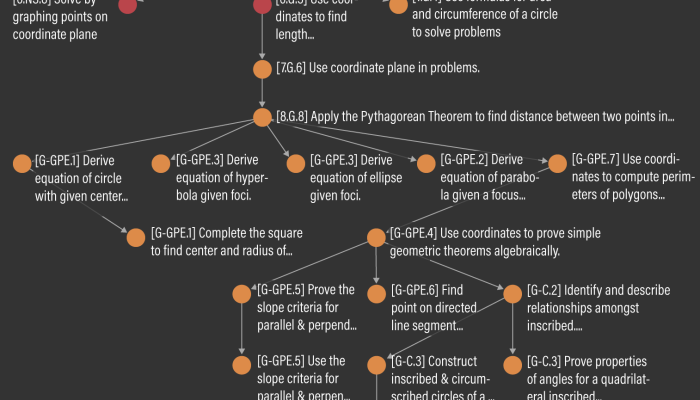
Modeling COVID-19 disruptions via network mapping of the Common Core Mathematics Standards
A unique method for promoting reflection among engineering students was used in the present study involving a digital circuits course. The method combined computer-based simulation for digital circuit design with reflective-thought prompts after a midterm exam for post-exam analysis and reflection. This method was first implemented in a microelectronics course using the SPICE simulator. Lessons learned from the initial implementation were applied to the digital circuits course. These lessons learned included the need to scaffold students in the use of the simulation tool for reflection, the need to balance frequency of reflection with student workload and fatigue, and question prompts that voluntarily elicit broad thought after a milestone event such as a midterm exam (versus a quiz). Using a published depth rubric, the assessment results found increased depth of reflection in the present course relative to the initial implementation in microelectronics. Specifically, there were increases in depth of reflection after the midterm exam in the present course versus the midterm exam and two quizzes in the microelectronics course. The increases in depth were significant relative to the quizzes. There was also an increase in the relative occurrence of broad reflections in the present course, with significant differences compared to the quizzes. Although significant differences were not found in the final exam averages based on depth of reflection after the midterm exam or participation in this reflection, results from a follow-up survey several months after the course ended indicated benefit for students. Specifically, 80% of those who competed the reflection exercise indicated a high or very high perceived benefit from doing so. Of the approximately 50% who chose not to complete the reflection exercise, the primary reasons were identified via the follow-up survey. Findings from this work align with and add to the developing literature on student reactions to reflection.
Integrating Computer Science across Wyoming’s K-12 Curriculum from Inception to Implementation: Analysis Using Systems Theory
A unique method for promoting reflection among engineering students was used in the present study involving a digital circuits course. The method combined computer-based simulation for digital circuit design with reflective-thought prompts after a midterm exam for post-exam analysis and reflection. This method was first implemented in a microelectronics course using the SPICE simulator. Lessons learned from the initial implementation were applied to the digital circuits course. These lessons learned included the need to scaffold students in the use of the simulation tool for reflection, the need to balance frequency of reflection with student workload and fatigue, and question prompts that voluntarily elicit broad thought after a milestone event such as a midterm exam (versus a quiz). Using a published depth rubric, the assessment results found increased depth of reflection in the present course relative to the initial implementation in microelectronics. Specifically, there were increases in depth of reflection after the midterm exam in the present course versus the midterm exam and two quizzes in the microelectronics course. The increases in depth were significant relative to the quizzes. There was also an increase in the relative occurrence of broad reflections in the present course, with significant differences compared to the quizzes. Although significant differences were not found in the final exam averages based on depth of reflection after the midterm exam or participation in this reflection, results from a follow-up survey several months after the course ended indicated benefit for students. Specifically, 80% of those who competed the reflection exercise indicated a high or very high perceived benefit from doing so. Of the approximately 50% who chose not to complete the reflection exercise, the primary reasons were identified via the follow-up survey. Findings from this work align with and add to the developing literature on student reactions to reflection.
Implementation of Lessons Learned to Simulation-Based Reflection in a Digital Circuits Course
A unique method for promoting reflection among engineering students was used in the present study involving a digital circuits course. The method combined computer-based simulation for digital circuit design with reflective-thought prompts after a midterm exam for post-exam analysis and reflection. This method was first implemented in a microelectronics course using the SPICE simulator. Lessons learned from the initial implementation were applied to the digital circuits course. These lessons learned included the need to scaffold students in the use of the simulation tool for reflection, the need to balance frequency of reflection with student workload and fatigue, and question prompts that voluntarily elicit broad thought after a milestone event such as a midterm exam (versus a quiz). Using a published depth rubric, the assessment results found increased depth of reflection in the present course relative to the initial implementation in microelectronics. Specifically, there were increases in depth of reflection after the midterm exam in the present course versus the midterm exam and two quizzes in the microelectronics course. The increases in depth were significant relative to the quizzes. There was also an increase in the relative occurrence of broad reflections in the present course, with significant differences compared to the quizzes. Although significant differences were not found in the final exam averages based on depth of reflection after the midterm exam or participation in this reflection, results from a follow-up survey several months after the course ended indicated benefit for students. Specifically, 80% of those who competed the reflection exercise indicated a high or very high perceived benefit from doing so. Of the approximately 50% who chose not to complete the reflection exercise, the primary reasons were identified via the follow-up survey. Findings from this work align with and add to the developing literature on student reactions to reflection.
Generating a Classroom Pulse from Active Windows on Student Computers
With technology embedded in an increasing number of educational contexts, it is prudent to identify ways in which instructors can leverage technology to benefit their pedagogical practices. The purpose of this study was to determine if information about students’ active windows on their personal computers could provide actionable information to inform real-time instructional interventions and post-lecture reflection on practices. The active window approach mitigates issues with prior data collection methods and provides an opportunity to capture complete, real-time student computer usage without the need to install spyware. Based on observing 68 first-year engineering students and 32 second-year engineering students in large engineering lectures, we generated error rates of 4.28% with a 95% confidence interval of [2.81%, 6.04%] in a structured computer use course setting and 6.89% with [4.42%, 10.17%] in a semi-structured use setting. To illustrate the type of information active window monitoring could provide, we captured active window data from 135 students every 12 seconds for an entire 75-minute lecture. The data was averaged to generate a timeline which provided insight into how students responded to the instructor’s methods. This research has immediate practical implications in course design, instructional strategies, and engineering education research methods.
Mobile Applications to Measure Students’ Engagement in Learning
Evidence-based instruction or active learning is being more widely implemented in college teaching, and there is a need for instructors, evaluators and researchers to quantify their implementation in order to, for example, determine the efficacy of a new instructional technique. Here we introduce a new method for measuring students’ level of engagement with their learning. The method relies on an established and research-based theoretical framework and is built in the form of a mobile application for the two most popular smartphone platforms. Five separate studies presented here establish the fidelity of the method, its ability to measure subtle variations among students within the same class, the students’ patterns of learning during out-of-class study periods, and the versatility of the app to make different measurements of learning in different contexts, including an exploratory examination of the impact of the sudden shift to remote learning prompted by the coronavirus pandemic.
Use of Open-source Software in Mechatronics and Robotics Engineering Education – Part II : Controller Implementation
This paper is the second part of a two-part study on promoting the use of Open-Source Software (OSS) in Mechatronics and Robotics Engineering (MRE) education. Part I demonstrated the capabilities and limitations of several popular OSS, namely, Python, Java, Modelica, and GNU Octave, in model simulation and analysis of dynamic systems, through a DC motor example. The DC motor was chosen as a representative of a large class of dynamic systems described by linear differential equations. The perceptions of MRE community members about the OSS and their applications, gathered through an online survey, were also presented in Part I. In this paper, another fundamental pillar of MRE systems development, i.e., controller implementation, is considered.
Science Teachers’ Perceptions and Attitudes towards the Integration of Digital books in their Classes
The goal of this paper is to describe the motivation, methodology and results of introducing Active Learning Techniques in a Digital Design course. Digital Design is a four-credit junior level course for electrical and computer-engineering technology majors at Farmingdale State College, State University of New York. The students enrolled in this course have a large range of skills in term of experience with laboratory equipment, computer-based tools, and programming. The course introduces students to VHDL Hardware Description Language as the design entry method for digital circuits and to Field Programmable Gate Arrays (FPGA) platforms for the implementation of the digital circuits. Active learning techniques implemented in the course offer students more learning opportunities, potentially improving students’ knowledge and skills in digital design.
Volume 12
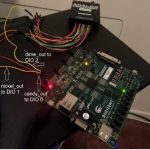
Active Learning Techniques in Digital Design Education for Engineering Technology Students
The goal of this paper is to describe the motivation, methodology and results of introducing Active Learning Techniques in a Digital Design course. Digital Design is a four-credit junior level course for electrical and computer-engineering technology majors at Farmingdale State College, State University of New York. The students enrolled in this course have a large range of skills in term of experience with laboratory equipment, computer-based tools, and programming. The course introduces students to VHDL Hardware Description Language as the design entry method for digital circuits and to Field Programmable Gate Arrays (FPGA) platforms for the implementation of the digital circuits. Active learning techniques implemented in the course offer students more learning opportunities, potentially improving students’ knowledge and skills in digital design.

Simulation-Based Reflection in a Digital Circuits Course
A unique method for promoting reflection among engineering students was used in the present study involving a digital circuits course. The method combined computer-based simulation for digital circuit design with reflective-thought prompts after a midterm exam for post-exam analysis and reflection. This method was first implemented in a microelectronics course using the SPICE simulator, and lessons learned from the initial implementation were applied to the digital circuits course. These lessons learned included the need to scaffold students in the use of the simulation tool for reflection, the need to balance frequency of reflection with student workload and fatigue, and the need for question prompts that voluntarily elicit broad thought after a milestone event such as a midterm exam (versus a quiz). Using a published depth rubric, the assessment results found increased depth of reflection in the present course relative to the initial implementation in microelectronics. Specifically, there were increases in depth of reflection after the midterm exam in the present course versus the midterm exam and two quizzes in the microelectronics course, and the increases in depth were significant relative to the quizzes. There was also an increase in the relative occurrence of broad reflections in the present course, with significant differences compared to the quizzes. Although significant differences were not found in the final exam averages based on depth of reflection after the midterm exam or participation in this reflection, results from a follow-up survey several months after the course ended indicated benefit for students. Specifically, 80% of those who competed the reflection exercise indicated a high or very high perceived benefit from doing so. Of the approximately 50% who chose not to complete the reflection exercise, the primary reasons were identified via the follow-up survey. Findings from this work align with and add to the developing literature on student reactions to reflection.
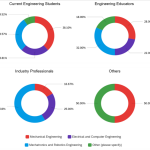
Use of Open-source Software in Mechatronics and Robotics Engineering Education – Part I: Model Simulation and Analysis
Open-source Software (OSS) provide attractive solutions for complementing Mechatronics and Robotics Engineering (MRE) education due to their numerous advantages such as free access, customizability and wide community support, increased adoption and utilization in industry, etc. To provide a deeper insight on the current status, limitations, and potentials of the OSS, a summary of the results of an online survey, conducted among various community stakeholders, is included. Furthermore, the two parts of this contribution are intended to provide an exposure to the OSS which have the potential to be used in MRE education. To this end, two specific problems, namely, model simulation and analysis of a DC motor (Part I) and controller implementation for a 2-DOF robot manipulator (Part II), are solved using Python, Java, Modelica, GNU Octave, and Gazebo. The systems chosen for this work are some of the most-commonly encountered systems and the considered problems, i.e. model simulation, analysis, and control implementation, are fundamental problems in the context of MRE. Therefore, this work can help MRE instructors familiar with these OSS to easily integrate them into their respective courses. On the other hand, the students can also greatly benefit from this work as it provides an entry point into applying different OSS in MRE-related courses and projects. Exposure to various ways in which an MRE problem is translated into a software solution enables the students to generalize their problem-solving process across different computational tools. Students equipped with such a skillset would potentially have a flexible mindset and could make well-balanced and informed judgements when devising a solution to a real-world engineering problem. Full code scripts for each of the OSS introduced in this work, along with Matlab which is intended as a point of comparison, are included on the GitHub repository of the paper to provide free access to the community and to help with widespread adoption of the OSS in MRE higher education.
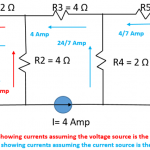
Using MULTISIM software as a replacement or supplement for physical labs
The article presented here demonstrates using MULTISIM as an educational tool to enhance student learning process by discussing the use of MULTISIM for teaching basic electrical circuits consisting of analysis of Series-Parallel Circuits, Superposition Theory, Thevenin Theory and Norton Theory. The article presented here discusses using the software as an aid to check the intermediate steps of hand calculation techniques that must be used if no computer software were being used.
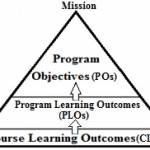
Learning Analytics of Outcomes-Based Engineering Programs’ Data
In the recent years, learning analytics is attracting attention in tertiary education sector. This paper presents a case study of applying learning analytics approaches to discover knowledge from Outcome Based (OB) engineering programs’ data. More specifically, Association Rule Mining approach is applied to a dataset extracted from the Self-Study Reports of 152 engineering programs accredited by American Board of Engineering and Technology (ABET)
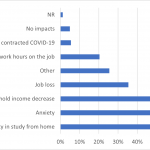
COVID-19 Technology Student Success Challenges : Influence of Tools and Strategies
COVID-19 brought rapid and substantial change to course formats as colleges and universities transitioned from on-campus to online instruction to mitigate the spread of the pandemic. While faculty and administrators sought solutions to maintain instructional quality and student success, students endeavored to adapt to the changes.
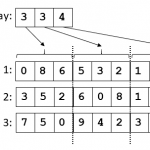
gruepr, a Software Tool for Optimally Partitioning Students onto Teams
This paper describes a new software tool named gruepr, written in C++ by the author. The code has been released under an open source license, and both the code and compiled binaries with a modern, graphical user interface for Windows and macOS have been made freely available
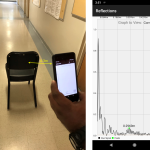
Teaching Signal Processing Applications using an Android Echolocation App
An Android application that realizes an audible version of echolocation has been implemented. Bundled within the app are videos, notes, problems, and discussion questions, thus creating an “eModule”.

Educational Challenges Presented by COVID-19 at Technical Colleges Offering Aviation Maintenance Technology Program
In mid-March, many schools in the United States were forced to stop teaching in-person classes and switch to an online format due to the COVID-19 pandemic; as a result, teachers had to quickly implement new technologies and instructional strategies in the classroom. This rapid pandemic response especially affected teachers and students in Aviation Maintenance Technology (AMT) programs around the country as AMT instruction is inherently hands-on in nature.
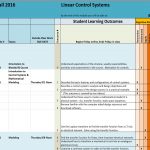
Multi-Year Case Study in Blended Design: Student Experiences in a Blended, Synchronous Distance Controls Course
This case study combines two primary areas of literature, blended learning and synchronous distance instruction. The literature provides various interpretations and definitions of blended learning. We define blended learning as a classroom learning model that integrates in-person and online asynchronous instruction with reduced time in class.
Randomly Selected Articles from the Archives
Exploring Literate Programming in Electrical Engineering Courses
Knuth’s literate programming paradigm positions source code as a work of literature for which communication to a human is prioritized over communication to a computer.
Analysis of Aircraft Actuator Failures within an Undergraduate Experiential Learning Laboratory
The design and implementation of an undergraduate laboratory is presented for the analysis of aircraft actuator failures through simulation.
Simulation and Interactive Digital Tools to Support Teaching Engineering Manufacturing Processes Course
Introduction of Manufacturing Processes is one of the core courses in most mechanical engineering, manufacturing engineering, and industrial engineering programs.
Promoting STEM to Middle School Girls through Coding and Fashion
Informal education approaches such as science camps have been used to promote interest in STEM fields for pre-college students. This paper presents the evaluation of outcomes of a computing outreach initiative targeting middle school aged girls from populations currently underrepresented in STEM.
Innovative VR-Based Research to Develop Intuitive Human Computer Interaction
This paper explains the design of a prototype desktop and augmented Virtual Reality (VR) framework as a medium to deliver instructional materials to the students in an introductory computer animation course.
A Pattern Recognition Framework for Embedded Systems
Embedded systems often implement behavior for common application domains, such as the control systems domain or the signal processing domain.
Project-Based Courses for B.Tech. Program of Robotics in Mechanical Engineering Technology
Robotics program at many Colleges has continued to become more and more popular. However, the students of the Bachelor of Technology (B.Tech.) program of robotics in the Mechanical Engineering Technology (MET) are facing three difficulties: (1) Weak fundamental knowledge related electrical engineering (EE), computer science (CS) and information technology (IT); (2) Difficulty in understanding the advanced concepts and theories of robotics; (3) Limited robotics class hours. Therefore, devising a series of appropriate robotics classes for the MET program is desirable.
Improving Student Success by Being Automatically Personal
This paper describes the development and use of “automatically-personal e-mail” routines allowing one to send interpretive e-mails to one’s class based on clicking a command in an Excel grade book.
The Effect of An Automatic Feedback System on Students’ Comments to Improve their Performance
This research focuses on understanding student performance by giving automatic feedback after writing freestyle comment data in each lesson.
An Integrated Framework for Learning Fundamentals in Computer Networks
This paper is archived under Volume 10 / Number 3 (July – September 2019).
Stimulating Higher Order Thinking in Mechatronics by Comparing PID and Fuzzy Control
This paper is archived under Volume 10 / Number 3 (July – September 2019).
Online Programs Increase the Availability of Education
This paper is archived under Volume 10 / Number 3 (July – September 2019).